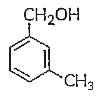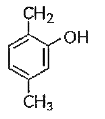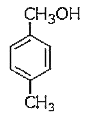Read the passage given below and answer the following questions 53-55. The electrochemical reduction of benzaldehyde and p-tolualdehyde has been achieved by diphenyl ditelluride and diphenyl diselenide as catalyst using undivided cell containing graphite (cathode) and aluminium (anode) electrodes. The products of electrochemical reduction are benzyl alcohol and p-methyl benzyl alcohol. They are characterised by by melting and boiling points. The yields of alcohol depends upon the kind of dichalcogenides compounds. The reduction is carried out in atmosphere of nitrogen. p-methyl benzaldehyde on reduction gives p-methyl benzyl alcohol.
Correct formula of p-methyl benzyl alcohol is:




To derive the correct formula for p-methylbenzyl alcohol, we can follow these steps:
1. Identify the Base Structure:
- Benzyl alcohol is the base structure we need to start with. Benzyl alcohol consists of a benzene ring (C6H5) attached to a -CH2OH group.
2. Add the Methyl Group:
- The term "p-methyl" indicates that there is a methyl (-CH3) group attached to the benzene ring. The "p" stands for para, meaning the methyl group is located at the 1,4-positions on the benzene ring relative to the hydroxyl (-OH) group.
3. Construct the Molecular Formula:
- The molecular formula for benzyl alcohol is C7H8O (C6H5 + CH2OH).
- When we add the methyl group (CH3) to the para position, we need to account for the additional carbon and hydrogen atoms.
- The new structure will have one more carbon and three more hydrogen atoms compared to benzyl alcohol.
4. Final Formula Calculation:
- The total number of carbon atoms is now 8 (C6 from the benzene + 1 from -CH2 + 1 from -CH3).
- The total number of hydrogen atoms is now 10 (5 from the benzene + 2 from -CH2 + 3 from -CH3 + 1 from -OH).
- Therefore, the final molecular formula for p-methylbenzyl alcohol is C8H10O.
Final Answer:
The correct formula for p-methylbenzyl alcohol is C8H10O.
---
- Benzyl alcohol is the base structure we need to start with. Benzyl alcohol consists of a benzene ring (C6H5) attached to a -CH2OH group.
- The term "p-methyl" indicates that there is a methyl (-CH3) group attached to the benzene ring. The "p" stands for para, meaning the methyl group is located at the 1,4-positions on the benzene ring relative to the hydroxyl (-OH) group.
- The molecular formula for benzyl alcohol is C7H8O (C6H5 + CH2OH).
- When we add the methyl group (CH3) to the para position, we need to account for the additional carbon and hydrogen atoms.
- The new structure will have one more carbon and three more hydrogen atoms compared to benzyl alcohol.
- The total number of carbon atoms is now 8 (C6 from the benzene + 1 from -CH2 + 1 from -CH3).
- The total number of hydrogen atoms is now 10 (5 from the benzene + 2 from -CH2 + 3 from -CH3 + 1 from -OH).
- Therefore, the final molecular formula for p-methylbenzyl alcohol is C8H10O.
The correct formula for p-methylbenzyl alcohol is C8H10O.
Topper's Solved these Questions
Similar Questions
Read the passage given below and answer the following questions 53-55. The electrochemical reduction of benzaldehyde and p-tolualdehyde has been achieved by diphenyl ditelluride and diphenyl diselenide as catalyst using undivided cell containing graphite (cathode) and aluminium (anode) electrodes. The products of electrochemical reduction are benzyl alcohol and p-methyl benzyl alcohol. They are characterised by by melting and boiling points. The yields of alcohol depends upon the kind of dichalcogenides compounds. The reduction is carried out in atmosphere of nitrogen. p-methyl benzaldehyde on reduction gives p-methyl benzyl alcohol.
Which alcohol will form turbidity (milkiness) with Lucas reagent immediately?
View SolutionRead the passage given below and answer the following questions 53-55. The electrochemical reduction of benzaldehyde and p-tolualdehyde has been achieved by diphenyl ditelluride and diphenyl diselenide as catalyst using undivided cell containing graphite (cathode) and aluminium (anode) electrodes. The products of electrochemical reduction are benzyl alcohol and p-methyl benzyl alcohol. They are characterised by by melting and boiling points. The yields of alcohol depends upon the kind of dichalcogenides compounds. The reduction is carried out in atmosphere of nitrogen. p-methyl benzaldehyde on reduction gives p-methyl benzyl alcohol.
Identify X in the following reaction CH3−CH=CH−CHONaBH4−−−−→'X' is
View Solution
Knowledge Check
Phenol and benzyl alcohol are
Afunctional isomersBHomologousCposition isomersDnone of theseO−Crsol & benzyl alcohol are
AFuctional isomersBPosition isomersCChain isomersDAll the aboveOxidation of alcohols depends upon _____
Anumber of carbon atom of alcoholB−OH group of alcoholsCnumber of hydrogen atoms attached to alcoholic carbonDhydrogen bonding in alcohol
How benzyl alcohol is obtained from benzyl chloride ?
View SolutionHow will you distinguish between benzyl alcohol and phenol ?
View SolutionOxidation products of alcohols depends upon
View SolutionConsider the following benzyl alcohol :

Correct order of their Kb value is :
View SolutionBenzaldehyde can be converted to benzyl alcohol by –
View Solution
